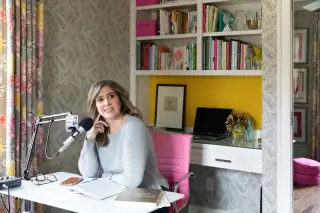6 Simple Tips to Create the Perfect Home Office, According to an Interior Designer

Even if you don’t have the luxury of a 60-second commute every day, chances are you spend at least some time working from home. As an interior designer and business coach to creative entrepreneurs, I've seen that if you put a little effort into setting up your home office area, you can reap massive rewards. Since moving my office into my home a few years ago, I’ve doubled my productivity and increased my income, thanks to fewer distractions and a space I customized for maximum creativity. You can do the same. Here’s how.
1. Make your home office too beautiful to say no to
You want to create a work space that is magnetic, so that it draws you in and creates the habit of regularly showing up and being ready to work. There are plenty of ways to do this. You can change your layout and add some nice décor, make your desk enticing with fresh flowers, invest in great office supplies or a comfy chair, or situate your space in a room with the perfect amount of sunlight and a nice (but not too distracting) view. Anything that you can do to make your workspace a place you actually want to stay in — and not drift away to the couch and the remote control — is going to do wonders for your productivity.
2. Surround yourself with the right colors
Research in the area of color psychology shows that color plays a role in productivity. For your office, you want a color that doesn’t agitate you but also doesn’t make you too lethargic. The sweet spot is something in the middle that is energizing but still refreshing and nurturing. I find yellows and blues are great for my own productivity.
Grays have been so popular in interior design over the last decade, but gray isn’t necessarily great for productivity. It can be too drab and depressing for many people. And white can be too stark. So pay attention to the color of your space and whether it makes you feel energized or ready for a nap — and then add more of the colors to your office that perk you up.
3. Set the mood with good lighting
Lighting plays a huge role in your productivity and in the way colors look, too. Fluorescent lighting is emotionally draining and can make colors in a space distorted, which can further impact your mood or output.
You ideally want natural sunlight or lighting quality that simulates natural light or even better, both! You need enough lighting to effectively execute the tasks on your to-do list. I also like layered lighting, like lamp lighting or what’s called ambient lighting, as it is more soft and comfortable than overhead lighting and makes me feel happier and more nurtured. As you create your office, try to notice how lighting makes you feel and find the option that works best for you
4. Find the right temperature
If your work space is too hot or too cold, it’s going to be hard to get your work done. Air quality is equally important. I am more productive when I can open a window or even take breaks outside to get fresh air. The air temperature is critical for productivity — too cold can sideline your focus and too warm can even put you to sleep.
I like to keep my office at 69 degrees — this is the perfect temperature for me. In winter months, I keep a small blanket nearby that I can put across my lap in order to stay warm while I get my work done. And in the summer, I keep a fan close by, in case I need a blast of air.
5. Create an idea incubator
Think about creating a space in your home that is distraction-free and that nurtures you to create your best ideas. I call this the “idea incubator.” It could be a pod or an elegant chair you sit in, all that matters is that when you sit there, it’s for one specific purpose: asking for creativity to strike.
6. Keep what you need nearby
The most important step in staying productive is gaining awareness of distractions so you can find solutions for them before they strike. For example, I love to keep a scented candle on my desk so I also have the lighter right there. When you’re in your work space, have everything you might need handy, so you won’t be tempted to get up — and then get distracted by the laundry or dirty dishes in the kitchen.
With a little bit of effort and energy, you can make working from home actually work for you.